Analyzing National Steps Challenge Health Campaign in Singapore
VerifiedAdded on 2022/08/11
|9
|2555
|31
Essay
AI Summary
This essay analyzes the National Steps Challenge, a health campaign initiated by the Health Promotion Board (HPB) in Singapore to combat the sedentary lifestyle of its population. The campaign, which began in 2015, utilizes step trackers and encourages participants to increase their physical activity through challenges and rewards. The essay highlights the campaign's cultural relevance, considering Singapore's diverse cultural mix influenced by European and Asian cultures, and the impact of dietary habits and cultural events on physical activity levels. The study further applies Hofstede's 6D model to understand the cultural dimensions of Singapore, providing insights into the country's values and how they influence the campaign's success. The analysis includes statistics on adolescent physical activity and concludes that cultural understanding is critical to health campaign effectiveness.
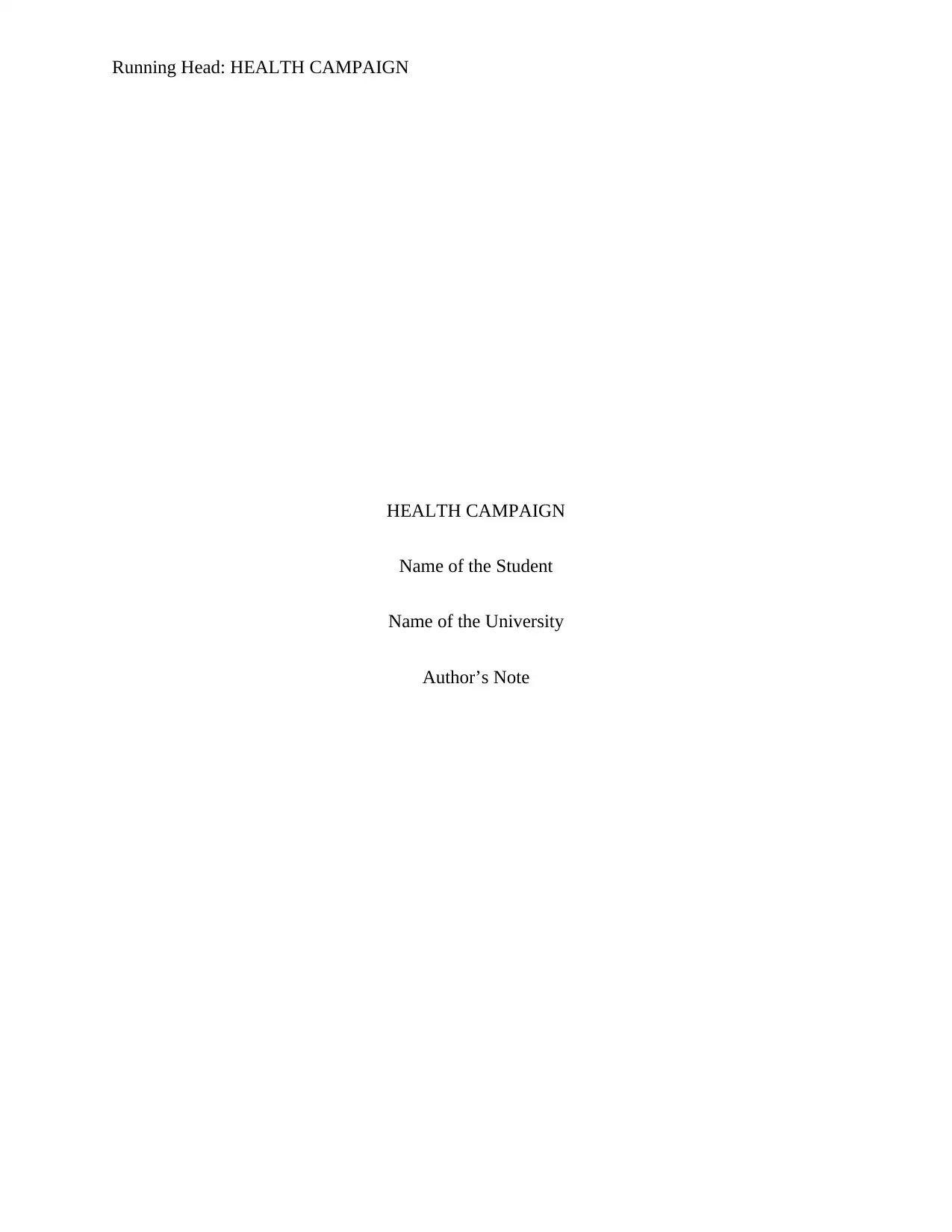
Running Head: HEALTH CAMPAIGN
HEALTH CAMPAIGN
Name of the Student
Name of the University
Author’s Note
HEALTH CAMPAIGN
Name of the Student
Name of the University
Author’s Note
Paraphrase This Document
Need a fresh take? Get an instant paraphrase of this document with our AI Paraphraser
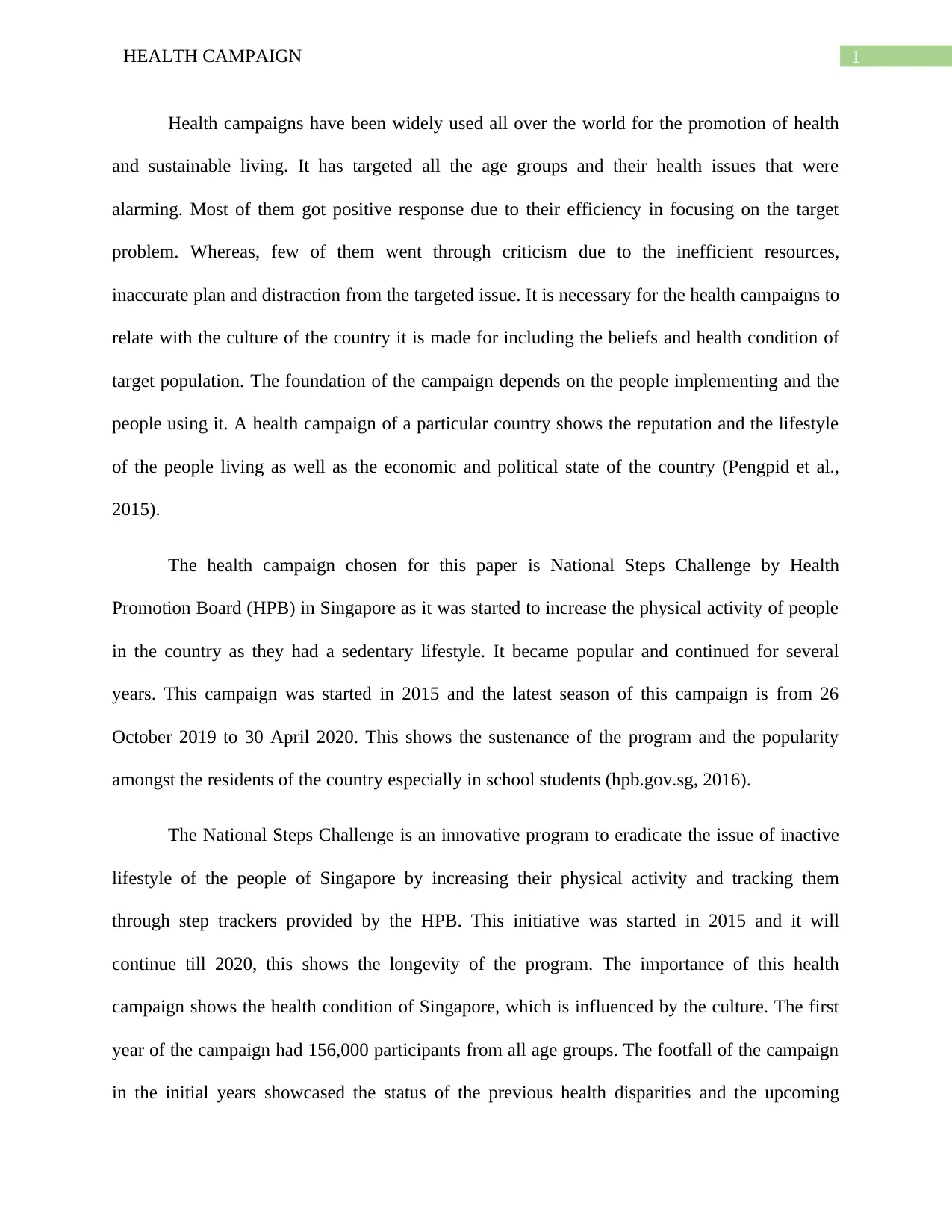
1HEALTH CAMPAIGN
Health campaigns have been widely used all over the world for the promotion of health
and sustainable living. It has targeted all the age groups and their health issues that were
alarming. Most of them got positive response due to their efficiency in focusing on the target
problem. Whereas, few of them went through criticism due to the inefficient resources,
inaccurate plan and distraction from the targeted issue. It is necessary for the health campaigns to
relate with the culture of the country it is made for including the beliefs and health condition of
target population. The foundation of the campaign depends on the people implementing and the
people using it. A health campaign of a particular country shows the reputation and the lifestyle
of the people living as well as the economic and political state of the country (Pengpid et al.,
2015).
The health campaign chosen for this paper is National Steps Challenge by Health
Promotion Board (HPB) in Singapore as it was started to increase the physical activity of people
in the country as they had a sedentary lifestyle. It became popular and continued for several
years. This campaign was started in 2015 and the latest season of this campaign is from 26
October 2019 to 30 April 2020. This shows the sustenance of the program and the popularity
amongst the residents of the country especially in school students (hpb.gov.sg, 2016).
The National Steps Challenge is an innovative program to eradicate the issue of inactive
lifestyle of the people of Singapore by increasing their physical activity and tracking them
through step trackers provided by the HPB. This initiative was started in 2015 and it will
continue till 2020, this shows the longevity of the program. The importance of this health
campaign shows the health condition of Singapore, which is influenced by the culture. The first
year of the campaign had 156,000 participants from all age groups. The footfall of the campaign
in the initial years showcased the status of the previous health disparities and the upcoming
Health campaigns have been widely used all over the world for the promotion of health
and sustainable living. It has targeted all the age groups and their health issues that were
alarming. Most of them got positive response due to their efficiency in focusing on the target
problem. Whereas, few of them went through criticism due to the inefficient resources,
inaccurate plan and distraction from the targeted issue. It is necessary for the health campaigns to
relate with the culture of the country it is made for including the beliefs and health condition of
target population. The foundation of the campaign depends on the people implementing and the
people using it. A health campaign of a particular country shows the reputation and the lifestyle
of the people living as well as the economic and political state of the country (Pengpid et al.,
2015).
The health campaign chosen for this paper is National Steps Challenge by Health
Promotion Board (HPB) in Singapore as it was started to increase the physical activity of people
in the country as they had a sedentary lifestyle. It became popular and continued for several
years. This campaign was started in 2015 and the latest season of this campaign is from 26
October 2019 to 30 April 2020. This shows the sustenance of the program and the popularity
amongst the residents of the country especially in school students (hpb.gov.sg, 2016).
The National Steps Challenge is an innovative program to eradicate the issue of inactive
lifestyle of the people of Singapore by increasing their physical activity and tracking them
through step trackers provided by the HPB. This initiative was started in 2015 and it will
continue till 2020, this shows the longevity of the program. The importance of this health
campaign shows the health condition of Singapore, which is influenced by the culture. The first
year of the campaign had 156,000 participants from all age groups. The footfall of the campaign
in the initial years showcased the status of the previous health disparities and the upcoming
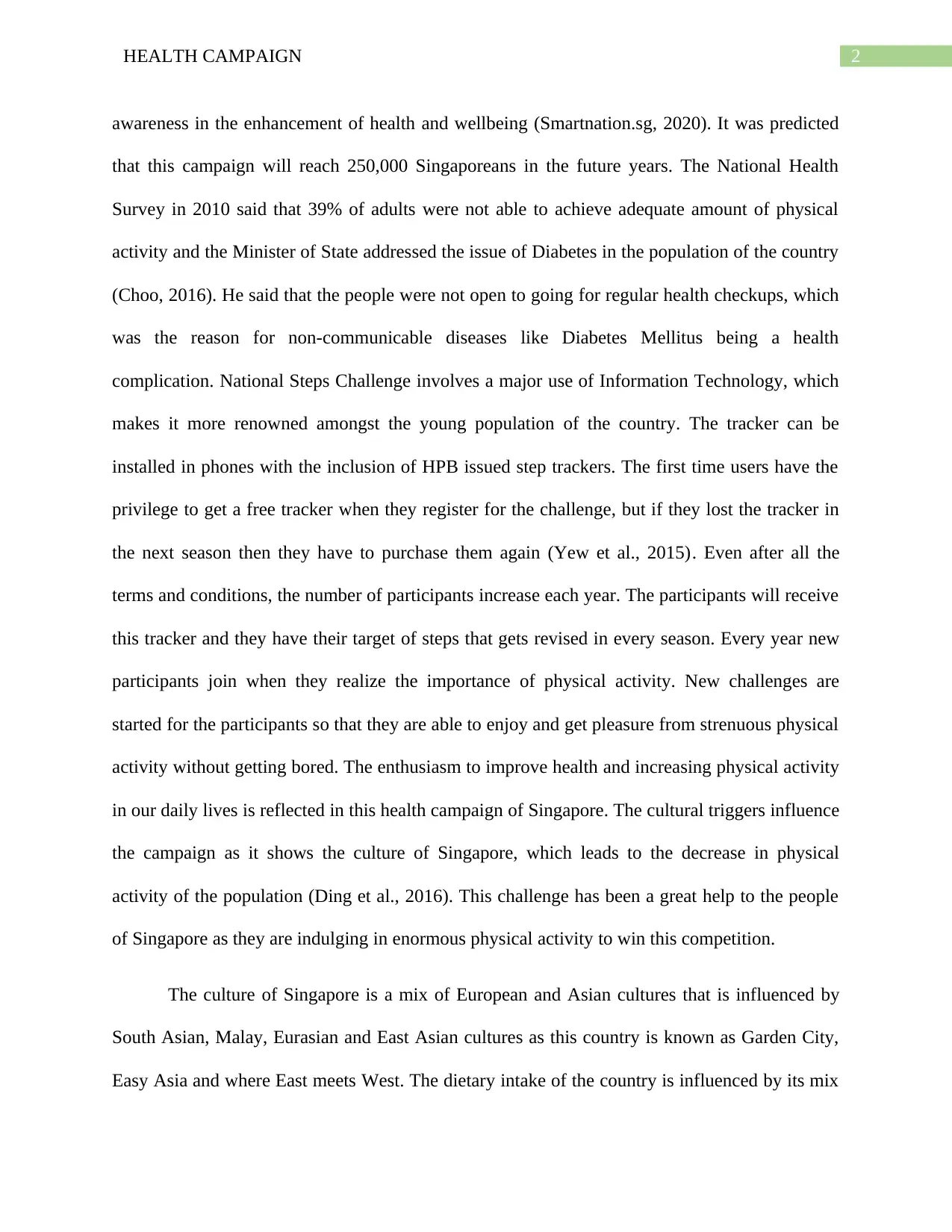
2HEALTH CAMPAIGN
awareness in the enhancement of health and wellbeing (Smartnation.sg, 2020). It was predicted
that this campaign will reach 250,000 Singaporeans in the future years. The National Health
Survey in 2010 said that 39% of adults were not able to achieve adequate amount of physical
activity and the Minister of State addressed the issue of Diabetes in the population of the country
(Choo, 2016). He said that the people were not open to going for regular health checkups, which
was the reason for non-communicable diseases like Diabetes Mellitus being a health
complication. National Steps Challenge involves a major use of Information Technology, which
makes it more renowned amongst the young population of the country. The tracker can be
installed in phones with the inclusion of HPB issued step trackers. The first time users have the
privilege to get a free tracker when they register for the challenge, but if they lost the tracker in
the next season then they have to purchase them again (Yew et al., 2015). Even after all the
terms and conditions, the number of participants increase each year. The participants will receive
this tracker and they have their target of steps that gets revised in every season. Every year new
participants join when they realize the importance of physical activity. New challenges are
started for the participants so that they are able to enjoy and get pleasure from strenuous physical
activity without getting bored. The enthusiasm to improve health and increasing physical activity
in our daily lives is reflected in this health campaign of Singapore. The cultural triggers influence
the campaign as it shows the culture of Singapore, which leads to the decrease in physical
activity of the population (Ding et al., 2016). This challenge has been a great help to the people
of Singapore as they are indulging in enormous physical activity to win this competition.
The culture of Singapore is a mix of European and Asian cultures that is influenced by
South Asian, Malay, Eurasian and East Asian cultures as this country is known as Garden City,
Easy Asia and where East meets West. The dietary intake of the country is influenced by its mix
awareness in the enhancement of health and wellbeing (Smartnation.sg, 2020). It was predicted
that this campaign will reach 250,000 Singaporeans in the future years. The National Health
Survey in 2010 said that 39% of adults were not able to achieve adequate amount of physical
activity and the Minister of State addressed the issue of Diabetes in the population of the country
(Choo, 2016). He said that the people were not open to going for regular health checkups, which
was the reason for non-communicable diseases like Diabetes Mellitus being a health
complication. National Steps Challenge involves a major use of Information Technology, which
makes it more renowned amongst the young population of the country. The tracker can be
installed in phones with the inclusion of HPB issued step trackers. The first time users have the
privilege to get a free tracker when they register for the challenge, but if they lost the tracker in
the next season then they have to purchase them again (Yew et al., 2015). Even after all the
terms and conditions, the number of participants increase each year. The participants will receive
this tracker and they have their target of steps that gets revised in every season. Every year new
participants join when they realize the importance of physical activity. New challenges are
started for the participants so that they are able to enjoy and get pleasure from strenuous physical
activity without getting bored. The enthusiasm to improve health and increasing physical activity
in our daily lives is reflected in this health campaign of Singapore. The cultural triggers influence
the campaign as it shows the culture of Singapore, which leads to the decrease in physical
activity of the population (Ding et al., 2016). This challenge has been a great help to the people
of Singapore as they are indulging in enormous physical activity to win this competition.
The culture of Singapore is a mix of European and Asian cultures that is influenced by
South Asian, Malay, Eurasian and East Asian cultures as this country is known as Garden City,
Easy Asia and where East meets West. The dietary intake of the country is influenced by its mix
⊘ This is a preview!⊘
Do you want full access?
Subscribe today to unlock all pages.

Trusted by 1+ million students worldwide
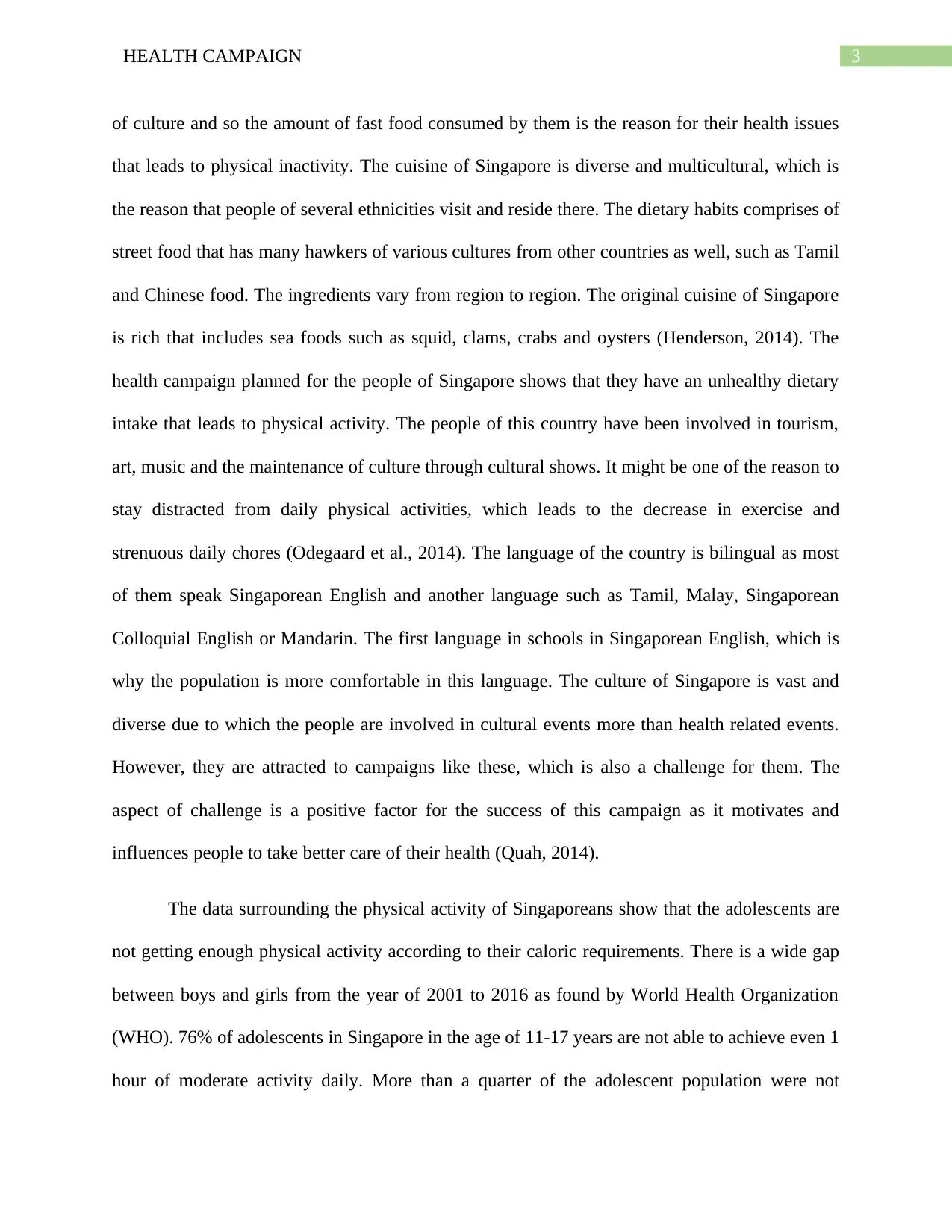
3HEALTH CAMPAIGN
of culture and so the amount of fast food consumed by them is the reason for their health issues
that leads to physical inactivity. The cuisine of Singapore is diverse and multicultural, which is
the reason that people of several ethnicities visit and reside there. The dietary habits comprises of
street food that has many hawkers of various cultures from other countries as well, such as Tamil
and Chinese food. The ingredients vary from region to region. The original cuisine of Singapore
is rich that includes sea foods such as squid, clams, crabs and oysters (Henderson, 2014). The
health campaign planned for the people of Singapore shows that they have an unhealthy dietary
intake that leads to physical activity. The people of this country have been involved in tourism,
art, music and the maintenance of culture through cultural shows. It might be one of the reason to
stay distracted from daily physical activities, which leads to the decrease in exercise and
strenuous daily chores (Odegaard et al., 2014). The language of the country is bilingual as most
of them speak Singaporean English and another language such as Tamil, Malay, Singaporean
Colloquial English or Mandarin. The first language in schools in Singaporean English, which is
why the population is more comfortable in this language. The culture of Singapore is vast and
diverse due to which the people are involved in cultural events more than health related events.
However, they are attracted to campaigns like these, which is also a challenge for them. The
aspect of challenge is a positive factor for the success of this campaign as it motivates and
influences people to take better care of their health (Quah, 2014).
The data surrounding the physical activity of Singaporeans show that the adolescents are
not getting enough physical activity according to their caloric requirements. There is a wide gap
between boys and girls from the year of 2001 to 2016 as found by World Health Organization
(WHO). 76% of adolescents in Singapore in the age of 11-17 years are not able to achieve even 1
hour of moderate activity daily. More than a quarter of the adolescent population were not
of culture and so the amount of fast food consumed by them is the reason for their health issues
that leads to physical inactivity. The cuisine of Singapore is diverse and multicultural, which is
the reason that people of several ethnicities visit and reside there. The dietary habits comprises of
street food that has many hawkers of various cultures from other countries as well, such as Tamil
and Chinese food. The ingredients vary from region to region. The original cuisine of Singapore
is rich that includes sea foods such as squid, clams, crabs and oysters (Henderson, 2014). The
health campaign planned for the people of Singapore shows that they have an unhealthy dietary
intake that leads to physical activity. The people of this country have been involved in tourism,
art, music and the maintenance of culture through cultural shows. It might be one of the reason to
stay distracted from daily physical activities, which leads to the decrease in exercise and
strenuous daily chores (Odegaard et al., 2014). The language of the country is bilingual as most
of them speak Singaporean English and another language such as Tamil, Malay, Singaporean
Colloquial English or Mandarin. The first language in schools in Singaporean English, which is
why the population is more comfortable in this language. The culture of Singapore is vast and
diverse due to which the people are involved in cultural events more than health related events.
However, they are attracted to campaigns like these, which is also a challenge for them. The
aspect of challenge is a positive factor for the success of this campaign as it motivates and
influences people to take better care of their health (Quah, 2014).
The data surrounding the physical activity of Singaporeans show that the adolescents are
not getting enough physical activity according to their caloric requirements. There is a wide gap
between boys and girls from the year of 2001 to 2016 as found by World Health Organization
(WHO). 76% of adolescents in Singapore in the age of 11-17 years are not able to achieve even 1
hour of moderate activity daily. More than a quarter of the adolescent population were not
Paraphrase This Document
Need a fresh take? Get an instant paraphrase of this document with our AI Paraphraser
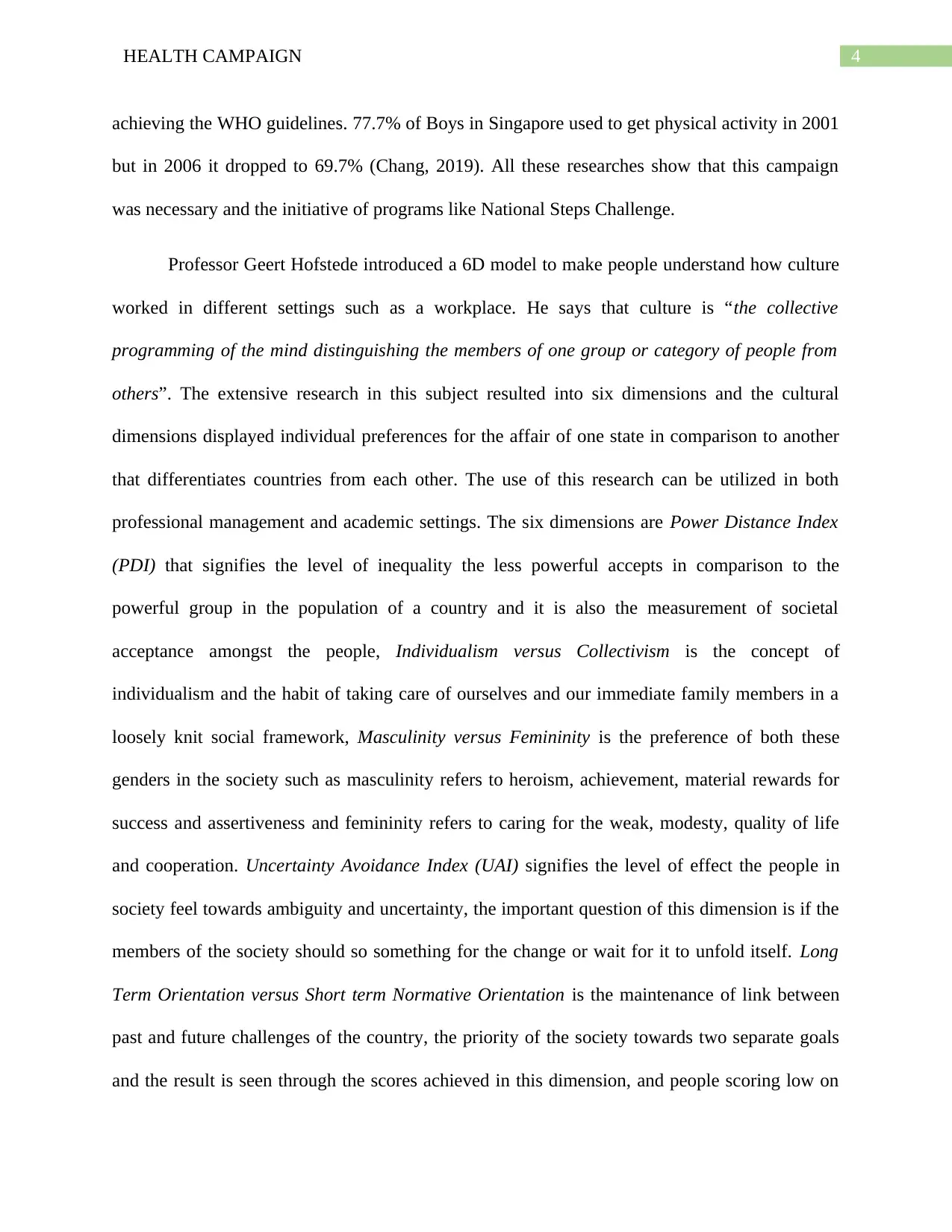
4HEALTH CAMPAIGN
achieving the WHO guidelines. 77.7% of Boys in Singapore used to get physical activity in 2001
but in 2006 it dropped to 69.7% (Chang, 2019). All these researches show that this campaign
was necessary and the initiative of programs like National Steps Challenge.
Professor Geert Hofstede introduced a 6D model to make people understand how culture
worked in different settings such as a workplace. He says that culture is “the collective
programming of the mind distinguishing the members of one group or category of people from
others”. The extensive research in this subject resulted into six dimensions and the cultural
dimensions displayed individual preferences for the affair of one state in comparison to another
that differentiates countries from each other. The use of this research can be utilized in both
professional management and academic settings. The six dimensions are Power Distance Index
(PDI) that signifies the level of inequality the less powerful accepts in comparison to the
powerful group in the population of a country and it is also the measurement of societal
acceptance amongst the people, Individualism versus Collectivism is the concept of
individualism and the habit of taking care of ourselves and our immediate family members in a
loosely knit social framework, Masculinity versus Femininity is the preference of both these
genders in the society such as masculinity refers to heroism, achievement, material rewards for
success and assertiveness and femininity refers to caring for the weak, modesty, quality of life
and cooperation. Uncertainty Avoidance Index (UAI) signifies the level of effect the people in
society feel towards ambiguity and uncertainty, the important question of this dimension is if the
members of the society should so something for the change or wait for it to unfold itself. Long
Term Orientation versus Short term Normative Orientation is the maintenance of link between
past and future challenges of the country, the priority of the society towards two separate goals
and the result is seen through the scores achieved in this dimension, and people scoring low on
achieving the WHO guidelines. 77.7% of Boys in Singapore used to get physical activity in 2001
but in 2006 it dropped to 69.7% (Chang, 2019). All these researches show that this campaign
was necessary and the initiative of programs like National Steps Challenge.
Professor Geert Hofstede introduced a 6D model to make people understand how culture
worked in different settings such as a workplace. He says that culture is “the collective
programming of the mind distinguishing the members of one group or category of people from
others”. The extensive research in this subject resulted into six dimensions and the cultural
dimensions displayed individual preferences for the affair of one state in comparison to another
that differentiates countries from each other. The use of this research can be utilized in both
professional management and academic settings. The six dimensions are Power Distance Index
(PDI) that signifies the level of inequality the less powerful accepts in comparison to the
powerful group in the population of a country and it is also the measurement of societal
acceptance amongst the people, Individualism versus Collectivism is the concept of
individualism and the habit of taking care of ourselves and our immediate family members in a
loosely knit social framework, Masculinity versus Femininity is the preference of both these
genders in the society such as masculinity refers to heroism, achievement, material rewards for
success and assertiveness and femininity refers to caring for the weak, modesty, quality of life
and cooperation. Uncertainty Avoidance Index (UAI) signifies the level of effect the people in
society feel towards ambiguity and uncertainty, the important question of this dimension is if the
members of the society should so something for the change or wait for it to unfold itself. Long
Term Orientation versus Short term Normative Orientation is the maintenance of link between
past and future challenges of the country, the priority of the society towards two separate goals
and the result is seen through the scores achieved in this dimension, and people scoring low on
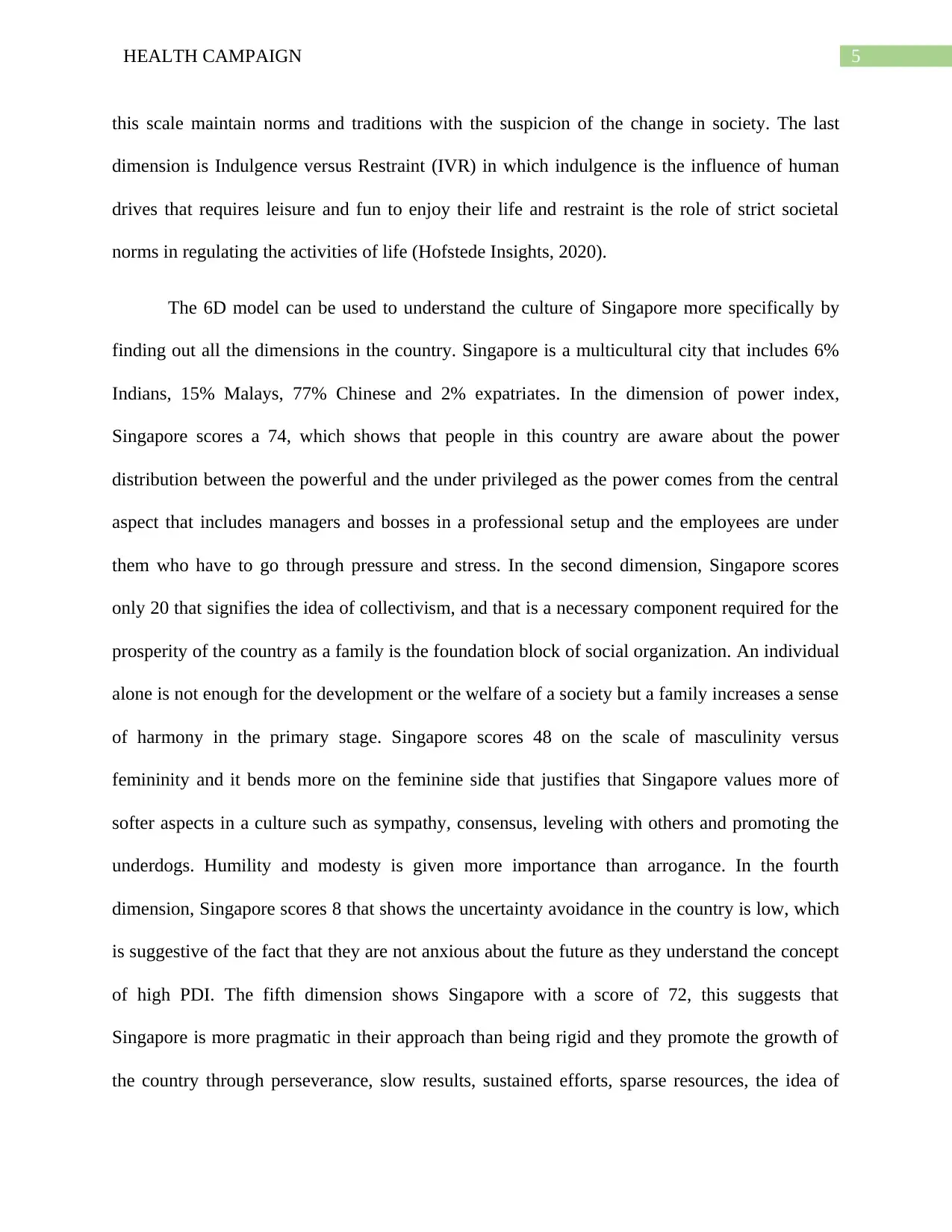
5HEALTH CAMPAIGN
this scale maintain norms and traditions with the suspicion of the change in society. The last
dimension is Indulgence versus Restraint (IVR) in which indulgence is the influence of human
drives that requires leisure and fun to enjoy their life and restraint is the role of strict societal
norms in regulating the activities of life (Hofstede Insights, 2020).
The 6D model can be used to understand the culture of Singapore more specifically by
finding out all the dimensions in the country. Singapore is a multicultural city that includes 6%
Indians, 15% Malays, 77% Chinese and 2% expatriates. In the dimension of power index,
Singapore scores a 74, which shows that people in this country are aware about the power
distribution between the powerful and the under privileged as the power comes from the central
aspect that includes managers and bosses in a professional setup and the employees are under
them who have to go through pressure and stress. In the second dimension, Singapore scores
only 20 that signifies the idea of collectivism, and that is a necessary component required for the
prosperity of the country as a family is the foundation block of social organization. An individual
alone is not enough for the development or the welfare of a society but a family increases a sense
of harmony in the primary stage. Singapore scores 48 on the scale of masculinity versus
femininity and it bends more on the feminine side that justifies that Singapore values more of
softer aspects in a culture such as sympathy, consensus, leveling with others and promoting the
underdogs. Humility and modesty is given more importance than arrogance. In the fourth
dimension, Singapore scores 8 that shows the uncertainty avoidance in the country is low, which
is suggestive of the fact that they are not anxious about the future as they understand the concept
of high PDI. The fifth dimension shows Singapore with a score of 72, this suggests that
Singapore is more pragmatic in their approach than being rigid and they promote the growth of
the country through perseverance, slow results, sustained efforts, sparse resources, the idea of
this scale maintain norms and traditions with the suspicion of the change in society. The last
dimension is Indulgence versus Restraint (IVR) in which indulgence is the influence of human
drives that requires leisure and fun to enjoy their life and restraint is the role of strict societal
norms in regulating the activities of life (Hofstede Insights, 2020).
The 6D model can be used to understand the culture of Singapore more specifically by
finding out all the dimensions in the country. Singapore is a multicultural city that includes 6%
Indians, 15% Malays, 77% Chinese and 2% expatriates. In the dimension of power index,
Singapore scores a 74, which shows that people in this country are aware about the power
distribution between the powerful and the under privileged as the power comes from the central
aspect that includes managers and bosses in a professional setup and the employees are under
them who have to go through pressure and stress. In the second dimension, Singapore scores
only 20 that signifies the idea of collectivism, and that is a necessary component required for the
prosperity of the country as a family is the foundation block of social organization. An individual
alone is not enough for the development or the welfare of a society but a family increases a sense
of harmony in the primary stage. Singapore scores 48 on the scale of masculinity versus
femininity and it bends more on the feminine side that justifies that Singapore values more of
softer aspects in a culture such as sympathy, consensus, leveling with others and promoting the
underdogs. Humility and modesty is given more importance than arrogance. In the fourth
dimension, Singapore scores 8 that shows the uncertainty avoidance in the country is low, which
is suggestive of the fact that they are not anxious about the future as they understand the concept
of high PDI. The fifth dimension shows Singapore with a score of 72, this suggests that
Singapore is more pragmatic in their approach than being rigid and they promote the growth of
the country through perseverance, slow results, sustained efforts, sparse resources, the idea of
⊘ This is a preview!⊘
Do you want full access?
Subscribe today to unlock all pages.

Trusted by 1+ million students worldwide
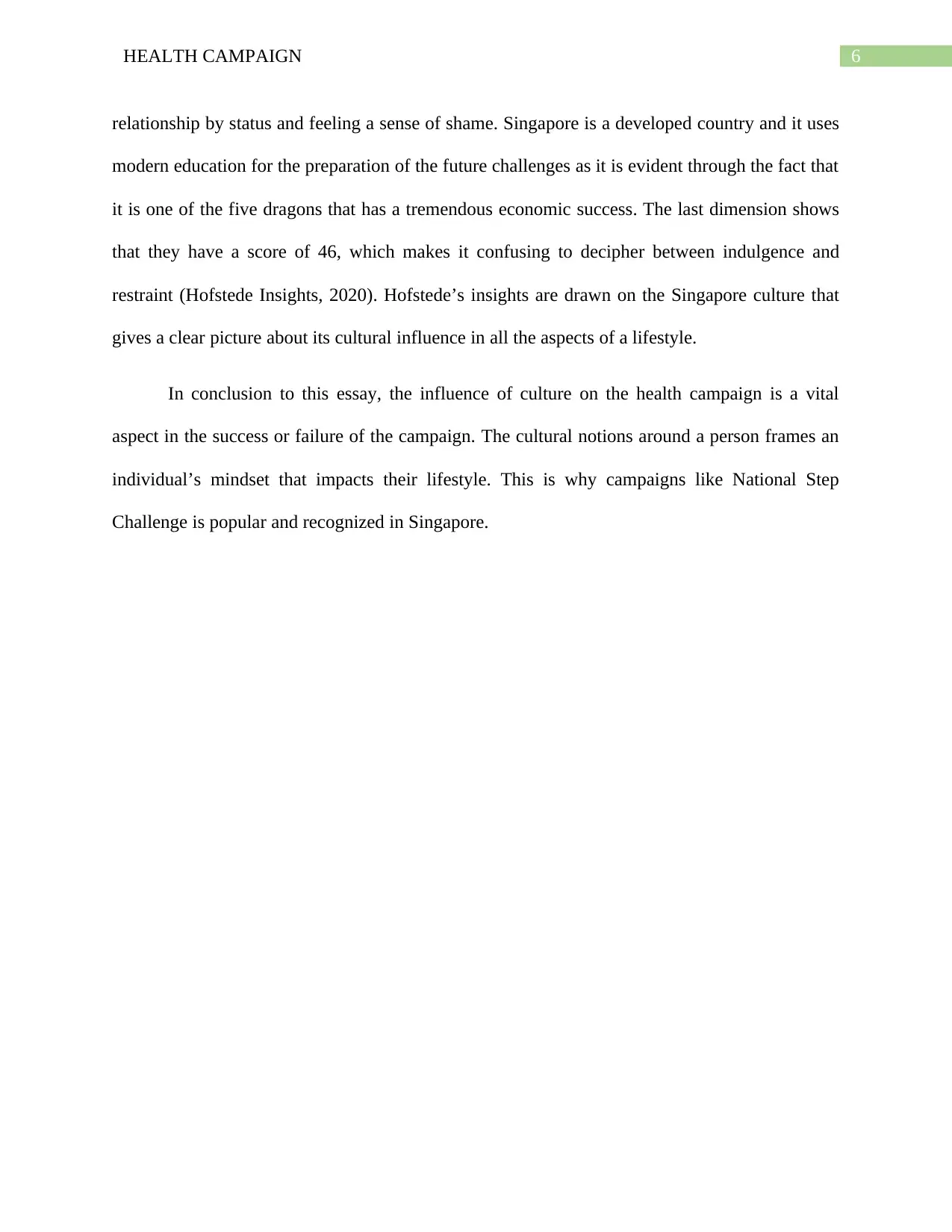
6HEALTH CAMPAIGN
relationship by status and feeling a sense of shame. Singapore is a developed country and it uses
modern education for the preparation of the future challenges as it is evident through the fact that
it is one of the five dragons that has a tremendous economic success. The last dimension shows
that they have a score of 46, which makes it confusing to decipher between indulgence and
restraint (Hofstede Insights, 2020). Hofstede’s insights are drawn on the Singapore culture that
gives a clear picture about its cultural influence in all the aspects of a lifestyle.
In conclusion to this essay, the influence of culture on the health campaign is a vital
aspect in the success or failure of the campaign. The cultural notions around a person frames an
individual’s mindset that impacts their lifestyle. This is why campaigns like National Step
Challenge is popular and recognized in Singapore.
relationship by status and feeling a sense of shame. Singapore is a developed country and it uses
modern education for the preparation of the future challenges as it is evident through the fact that
it is one of the five dragons that has a tremendous economic success. The last dimension shows
that they have a score of 46, which makes it confusing to decipher between indulgence and
restraint (Hofstede Insights, 2020). Hofstede’s insights are drawn on the Singapore culture that
gives a clear picture about its cultural influence in all the aspects of a lifestyle.
In conclusion to this essay, the influence of culture on the health campaign is a vital
aspect in the success or failure of the campaign. The cultural notions around a person frames an
individual’s mindset that impacts their lifestyle. This is why campaigns like National Step
Challenge is popular and recognized in Singapore.
Paraphrase This Document
Need a fresh take? Get an instant paraphrase of this document with our AI Paraphraser
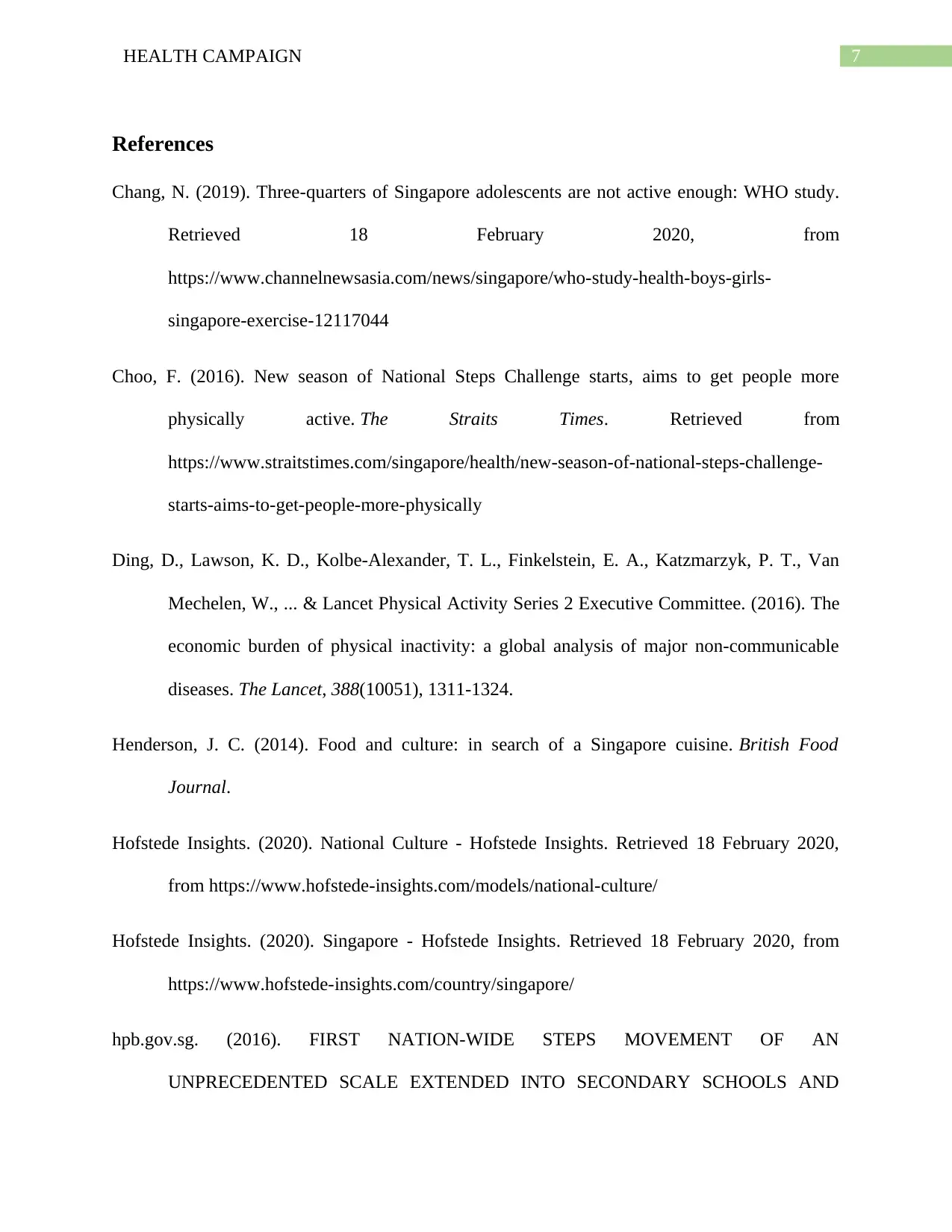
7HEALTH CAMPAIGN
References
Chang, N. (2019). Three-quarters of Singapore adolescents are not active enough: WHO study.
Retrieved 18 February 2020, from
https://www.channelnewsasia.com/news/singapore/who-study-health-boys-girls-
singapore-exercise-12117044
Choo, F. (2016). New season of National Steps Challenge starts, aims to get people more
physically active. The Straits Times. Retrieved from
https://www.straitstimes.com/singapore/health/new-season-of-national-steps-challenge-
starts-aims-to-get-people-more-physically
Ding, D., Lawson, K. D., Kolbe-Alexander, T. L., Finkelstein, E. A., Katzmarzyk, P. T., Van
Mechelen, W., ... & Lancet Physical Activity Series 2 Executive Committee. (2016). The
economic burden of physical inactivity: a global analysis of major non-communicable
diseases. The Lancet, 388(10051), 1311-1324.
Henderson, J. C. (2014). Food and culture: in search of a Singapore cuisine. British Food
Journal.
Hofstede Insights. (2020). National Culture - Hofstede Insights. Retrieved 18 February 2020,
from https://www.hofstede-insights.com/models/national-culture/
Hofstede Insights. (2020). Singapore - Hofstede Insights. Retrieved 18 February 2020, from
https://www.hofstede-insights.com/country/singapore/
hpb.gov.sg. (2016). FIRST NATION-WIDE STEPS MOVEMENT OF AN
UNPRECEDENTED SCALE EXTENDED INTO SECONDARY SCHOOLS AND
References
Chang, N. (2019). Three-quarters of Singapore adolescents are not active enough: WHO study.
Retrieved 18 February 2020, from
https://www.channelnewsasia.com/news/singapore/who-study-health-boys-girls-
singapore-exercise-12117044
Choo, F. (2016). New season of National Steps Challenge starts, aims to get people more
physically active. The Straits Times. Retrieved from
https://www.straitstimes.com/singapore/health/new-season-of-national-steps-challenge-
starts-aims-to-get-people-more-physically
Ding, D., Lawson, K. D., Kolbe-Alexander, T. L., Finkelstein, E. A., Katzmarzyk, P. T., Van
Mechelen, W., ... & Lancet Physical Activity Series 2 Executive Committee. (2016). The
economic burden of physical inactivity: a global analysis of major non-communicable
diseases. The Lancet, 388(10051), 1311-1324.
Henderson, J. C. (2014). Food and culture: in search of a Singapore cuisine. British Food
Journal.
Hofstede Insights. (2020). National Culture - Hofstede Insights. Retrieved 18 February 2020,
from https://www.hofstede-insights.com/models/national-culture/
Hofstede Insights. (2020). Singapore - Hofstede Insights. Retrieved 18 February 2020, from
https://www.hofstede-insights.com/country/singapore/
hpb.gov.sg. (2016). FIRST NATION-WIDE STEPS MOVEMENT OF AN
UNPRECEDENTED SCALE EXTENDED INTO SECONDARY SCHOOLS AND
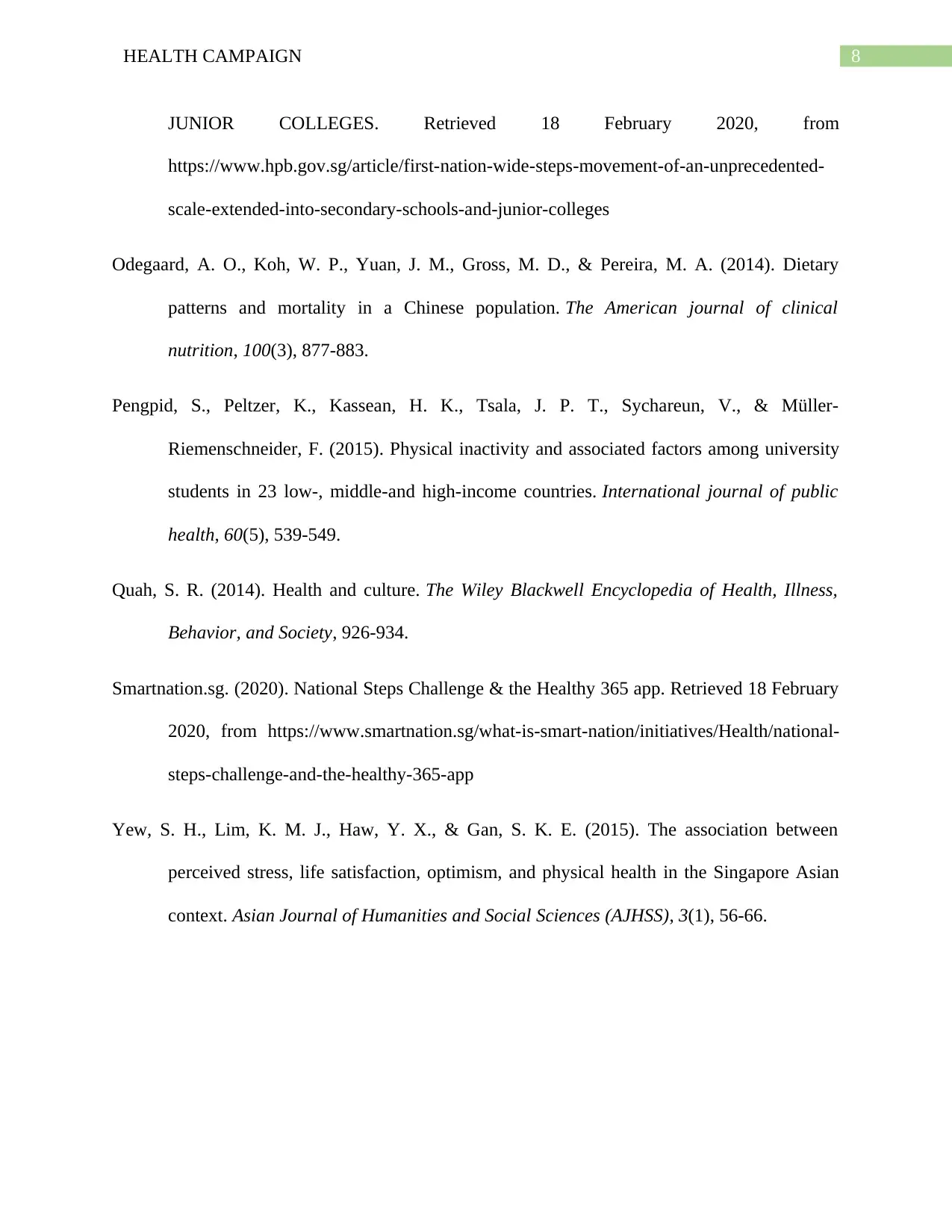
8HEALTH CAMPAIGN
JUNIOR COLLEGES. Retrieved 18 February 2020, from
https://www.hpb.gov.sg/article/first-nation-wide-steps-movement-of-an-unprecedented-
scale-extended-into-secondary-schools-and-junior-colleges
Odegaard, A. O., Koh, W. P., Yuan, J. M., Gross, M. D., & Pereira, M. A. (2014). Dietary
patterns and mortality in a Chinese population. The American journal of clinical
nutrition, 100(3), 877-883.
Pengpid, S., Peltzer, K., Kassean, H. K., Tsala, J. P. T., Sychareun, V., & Müller-
Riemenschneider, F. (2015). Physical inactivity and associated factors among university
students in 23 low-, middle-and high-income countries. International journal of public
health, 60(5), 539-549.
Quah, S. R. (2014). Health and culture. The Wiley Blackwell Encyclopedia of Health, Illness,
Behavior, and Society, 926-934.
Smartnation.sg. (2020). National Steps Challenge & the Healthy 365 app. Retrieved 18 February
2020, from https://www.smartnation.sg/what-is-smart-nation/initiatives/Health/national-
steps-challenge-and-the-healthy-365-app
Yew, S. H., Lim, K. M. J., Haw, Y. X., & Gan, S. K. E. (2015). The association between
perceived stress, life satisfaction, optimism, and physical health in the Singapore Asian
context. Asian Journal of Humanities and Social Sciences (AJHSS), 3(1), 56-66.
JUNIOR COLLEGES. Retrieved 18 February 2020, from
https://www.hpb.gov.sg/article/first-nation-wide-steps-movement-of-an-unprecedented-
scale-extended-into-secondary-schools-and-junior-colleges
Odegaard, A. O., Koh, W. P., Yuan, J. M., Gross, M. D., & Pereira, M. A. (2014). Dietary
patterns and mortality in a Chinese population. The American journal of clinical
nutrition, 100(3), 877-883.
Pengpid, S., Peltzer, K., Kassean, H. K., Tsala, J. P. T., Sychareun, V., & Müller-
Riemenschneider, F. (2015). Physical inactivity and associated factors among university
students in 23 low-, middle-and high-income countries. International journal of public
health, 60(5), 539-549.
Quah, S. R. (2014). Health and culture. The Wiley Blackwell Encyclopedia of Health, Illness,
Behavior, and Society, 926-934.
Smartnation.sg. (2020). National Steps Challenge & the Healthy 365 app. Retrieved 18 February
2020, from https://www.smartnation.sg/what-is-smart-nation/initiatives/Health/national-
steps-challenge-and-the-healthy-365-app
Yew, S. H., Lim, K. M. J., Haw, Y. X., & Gan, S. K. E. (2015). The association between
perceived stress, life satisfaction, optimism, and physical health in the Singapore Asian
context. Asian Journal of Humanities and Social Sciences (AJHSS), 3(1), 56-66.
⊘ This is a preview!⊘
Do you want full access?
Subscribe today to unlock all pages.

Trusted by 1+ million students worldwide
1 out of 9
Related Documents
Your All-in-One AI-Powered Toolkit for Academic Success.
+13062052269
info@desklib.com
Available 24*7 on WhatsApp / Email
![[object Object]](/_next/static/media/star-bottom.7253800d.svg)
Unlock your academic potential
Copyright © 2020–2026 A2Z Services. All Rights Reserved. Developed and managed by ZUCOL.




